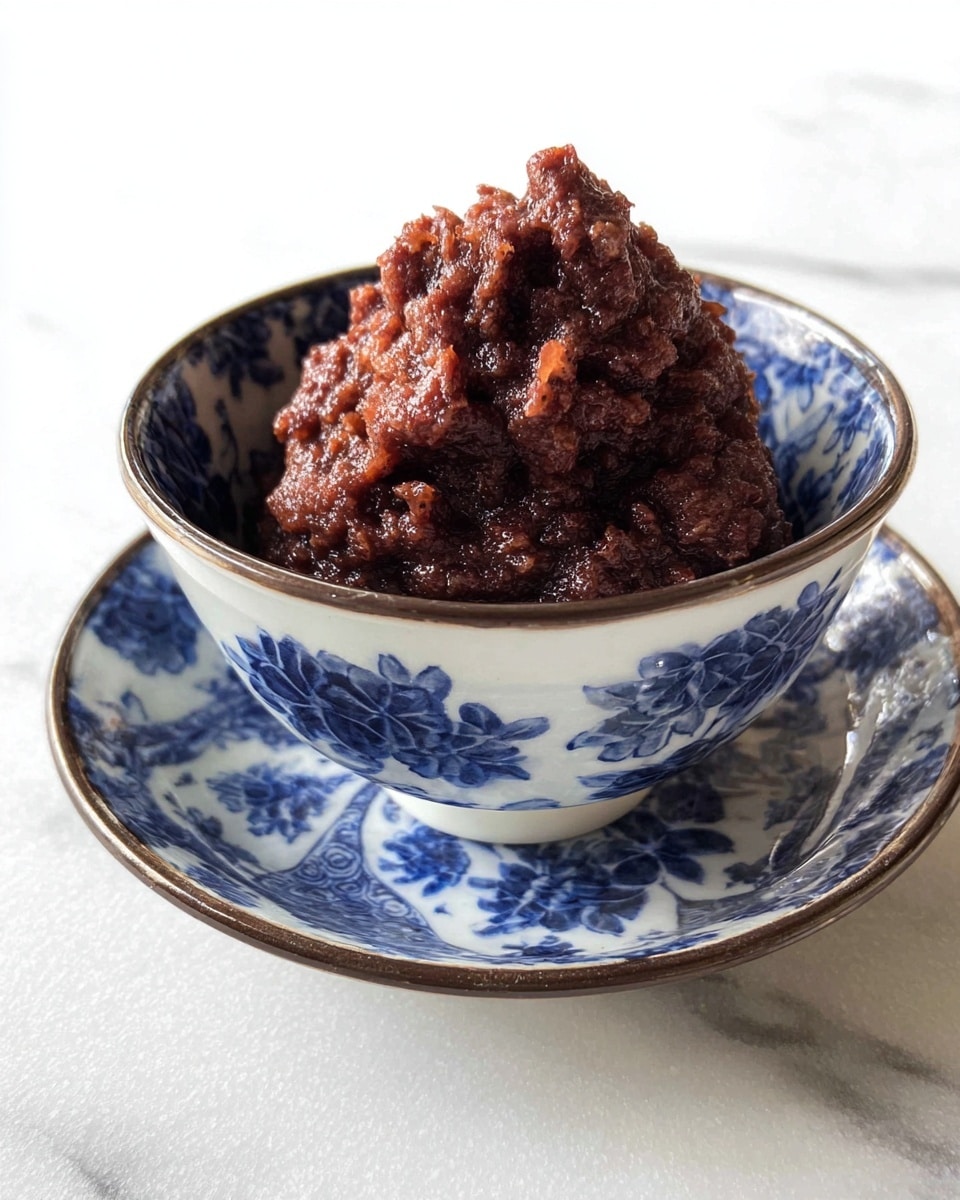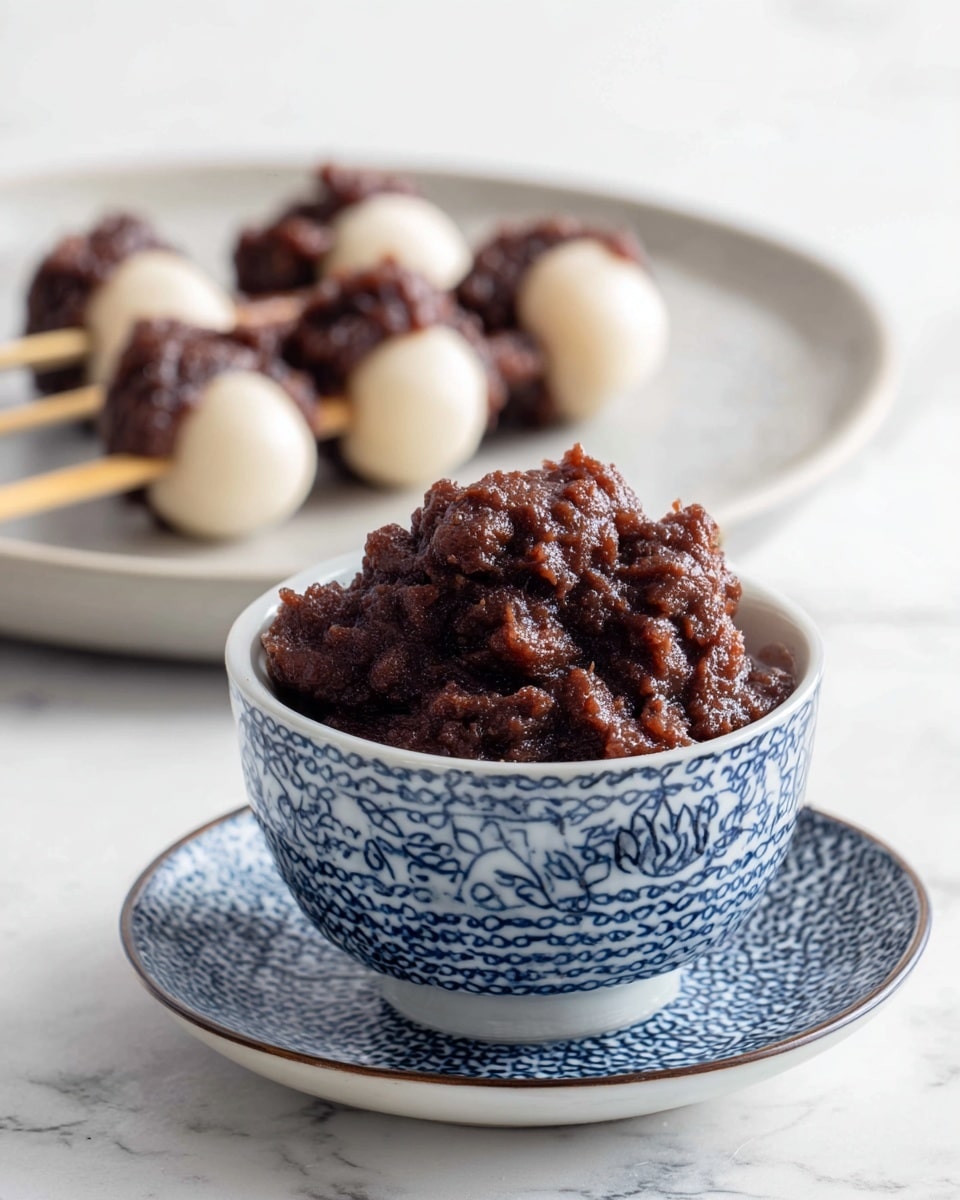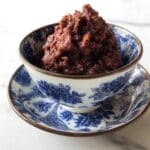Anko (Japanese Sweet Red Bean Paste) Recipe

I’m genuinely excited to share this Anko (Japanese Sweet Red Bean Paste) Recipe with you! If you’ve ever enjoyed a delicate mochi or anda staple from a Japanese bakery, you know the magic a silky, sweet red bean paste brings to those treats. Making your own anko at home feels like a little kitchen adventure—and trust me, it’s worth every minute. It’s simple, comforting, and wonderfully versatile for all sorts of desserts and snacks.
One thing I love about this Anko (Japanese Sweet Red Bean Paste) Recipe is how it transforms humble azuki beans into something truly soulful. Whether you’re spreading it on toast, filling dorayaki pancakes, or dolloping it next to ice cream, homemade anko always steals the show. Plus, once you master this recipe, you’ll have a handy staple that keeps your dessert game authentic and impressive.
Ingredients You’ll Need
These ingredients are straightforward, but each one plays a crucial role in creating that perfect balance between sweet and earthy in your anko. Shopping tip: Look for high-quality azuki beans—they make a noticeable difference!
- Azuki beans: The star ingredient. Dry azuki beans are best for control over sweetness and texture.
- Sugar: Granulated sugar helps achieve that classic sweet flavor. You can adjust based on your taste preference.
- Salt: Just a pinch to enhance the flavor and balance the sweetness.
- Boiling water: Needed to soak and cook the beans evenly without them bursting or becoming mushy.
- Water: Used during simmering to soften the beans gently.
Variations
I love playing around with the texture of my anko, so feel free to tweak it to your liking. Whether chunky or smooth, this recipe invites a bit of customization that helps you make it your own.
- Chunky Anko: Leave some beans whole for a rustic, hearty texture. This is how I often enjoy it with toast.
- Smooth Anko (Koshian): Blend the final paste for a velvety, smooth finish—perfect for delicate wagashi sweets.
- Reduced Sugar: I’ve experimented with cutting the sugar by half when pairing anko with naturally sweet fruits.
- Matcha Flavor Boost: Stir in a pinch of matcha powder to add a subtle grassy note—great for more complex desserts.
How to Make Anko (Japanese Sweet Red Bean Paste) Recipe
Step 1: Soak and Rinse Your Azuki Beans
Start by thoroughly rinsing 1 cup of dry azuki beans under cold water. Then, cover them with boiling water by about 1 cm and let them soak for an hour. This soaking step softens the beans and helps reduce cooking time, so don’t skip it—it really makes your anko smoother and ensures even cooking.
Step 2: Boil and Simmer the Beans
Drain the soaking water and add fresh water, about 5 cups, to a pot with the beans. Bring to a boil, then reduce to a simmer uncovered for around 1.5 hours. During cooking, skim off any foam or skin impurities that rise to the surface. This keeps your anko clean-tasting and free of bitterness. You want the beans wonderfully soft but not falling apart.
Step 3: Sweeten and Mash
Once the beans are tender, reduce heat and stir in 1 cup of sugar along with a pinch of salt. Cook gently, stirring constantly to avoid burning, until the sugar dissolves and the mixture thickens. Mash some beans slightly with the back of your spoon if you like a chunkier texture, or use a food mill or blender for a smooth paste. Remember, patience here pays off—an authentic anko shouldn’t feel rushed.
How to Serve Anko (Japanese Sweet Red Bean Paste) Recipe

Garnishes
I usually sprinkle a few toasted sesame seeds on top or add a small dusting of kinako (roasted soy flour) for an extra layer of flavor and texture. These simple garnishes add a lovely nutty note that pairs beautifully with the sweet beans.
Side Dishes
Serving anko alongside matcha green tea is my go-to. The bitterness of matcha perfectly balances the sweetness of the paste. I also enjoy it with plain mochi or used as a filling in dorayaki pancakes – it’s a classic combination that never disappoints.
Creative Ways to Present
For special occasions, I like to spoon anko into bite-sized lacquered dishes and accompany it with crisp seasonal fruits like persimmons or strawberries. Another fun idea is swirling anko into yogurt or ice cream for an elegant dessert twist that’s always a conversation starter.
Make Ahead and Storage
Storing Leftovers
Leftover anko can be stored in an airtight container in the fridge for up to a week. I find it’s best to smooth the top surface with the back of a spoon before sealing—it prevents drying out and keeps the texture just right.
Freezing
I freeze anko in small portions using silicone muffin trays, then transfer the frozen cubes to a zip-lock bag. This way, I can thaw just what I need for a single recipe without waiting ages—super handy for last-minute dessert needs.
Reheating
When reheating, gently warm anko in a small saucepan over low heat while stirring to prevent scorching. Adding just a splash of water helps loosen it back up to that perfect spreadable consistency, making it taste freshly made all over again.
FAQs
-
Can I use canned azuki beans for making anko?
While canned azuki beans can save time, they often have added salt and preservatives that affect the flavor and texture. For authentic taste and best control over sweetness, I recommend starting with dry beans for this Anko (Japanese Sweet Red Bean Paste) Recipe.
-
How long does homemade anko last in the fridge?
Properly stored in an airtight container, homemade anko lasts up to one week in the fridge. Always check for any signs of spoilage before use, though I rarely keep it longer than a few days because it’s so delicious!
-
Can I make anko without sugar?
Technically yes, but sugar is key to achieving the traditional sweet flavor of anko. If you want to reduce sugar, try using alternative sweeteners or add natural sweetness from fruits, but keep in mind this changes the classic taste.
-
What desserts work best with anko?
Anko is incredibly versatile: it shines in mochi, dorayaki, taiyaki, and even ice cream. It also works beautifully as a spread for toast or paired with fresh fruit. The key is to balance anko’s sweetness with complementary textures and flavors.
Final Thoughts
Making this Anko (Japanese Sweet Red Bean Paste) Recipe has been one of those kitchen joys for me—a simple process that yields such a rich, comforting result. I hope you’ll enjoy the process as much as I do and find a special place for anko in your home cooking. Whether you’re a seasoned fan of Japanese sweets or trying it for the first time, homemade anko adds an authentic, warm touch you’ll keep coming back to.
PrintAnko (Japanese Sweet Red Bean Paste) Recipe
Anko is a traditional Japanese sweet red bean paste made from azuki beans, sugar, and a pinch of salt. It is commonly used as a filling in many Japanese sweets such as mochi, dorayaki, and taiyaki. This recipe yields a smooth and sweet paste with a rich, natural flavor from the azuki beans, perfect for adding an authentic touch to your desserts.
- Prep Time: 15 minutes
- Cook Time: 1 hour 30 minutes
- Total Time: 1 hour 45 minutes
- Yield: Approximately 2 cups of anko paste 1x
- Category: Dessert
- Method: Stovetop
- Cuisine: Japanese
- Diet: Vegetarian
Ingredients
Ingredients
- 1 cup azuki beans (200g / 7oz)
- 1 cup sugar (200g / 7oz)
- 1 pinch salt
- Boiling water (enough to cover the beans about 1 cm / 1/2 inch above the top)
- 5 cups water
Instructions
- Soak and Rinse Beans: Rinse the azuki beans under cold water to remove any impurities and excess starch.
- Boil Beans: In a pot, add the rinsed beans and enough boiling water to cover them about 1 cm (1/2 inch) above the beans. Bring to a boil and cook for 5 minutes, then drain the water to remove bitterness.
- Simmer Beans: Refill the pot with 5 cups of fresh water and simmer the beans on low heat for 1 to 1.5 hours, or until the beans are tender, stirring occasionally to prevent sticking.
- Add Sugar and Salt: Drain the cooking water, leaving a small amount to adjust consistency. Add sugar and salt to the beans and gently mix over low heat until the sugar dissolves completely and the beans become thick and paste-like. Adjust the amount of water to achieve desired thickness.
- Cool and Store: Let the anko cool completely before using it as a filling or topping. Store in an airtight container in the refrigerator for up to one week or freeze for longer storage.
Notes
- Use azuki beans for authentic flavor; canned red beans can be used but fresh gives best results.
- Cook beans gently to avoid breaking them apart too much unless a smooth paste is desired.
- Adjust sugar level according to your preference for sweetness.
- Anko can be mashed for a smoother consistency or left chunky as tsubuan style paste.
- Store anko refrigerated and consume within a week for freshness.
Keywords: anko, japanese sweet red bean paste, azuki beans, anko recipe, traditional japanese dessert filling







